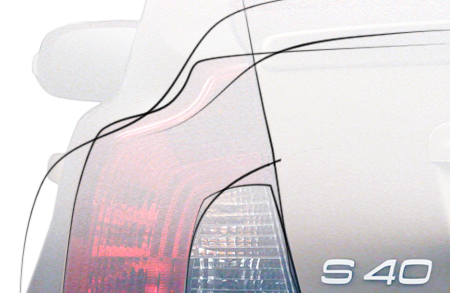The new Volvo S40
From: Régis Kuckaertz
Volvo has redesigned (sic) the S40 model, following a few — scandinavian — design principles:
1 Less is more
2 Treat everything like a piece of art
3 Form follows function
4 Redefine luxury
5 Never stop learning
Seems to be the perfect car for a designer!

Seagate packaging like Apple
From: Ross Hill
I just came across How Seagate learned to package like Apple. and thought you might be interested. A ‘corporate’ company jumping on the design bandwagon – with human copywriting.

“Crap” design regurgitated as “good” design
From: Yong Bakos
Check out the last half of this post from David Byrne, on design masters feigning crap design as style.
I guess at some point designers (and others) get bored with “good” design and the increasing ease of making tasteful design that looks more or less like everything else, which is exactly the point, and also not the point. At some point I guess people designing things want them to look tasteful so that they’ll appeal to a semi-sophisticated crowd. And now it’s pretty easy to do that. With computers, and under the influence of the wealth of slick packaging in the world, tasteful layouts are pretty easy to emulate. The general public is fairly sophisticated in their design sense these days — they “read” the language of design — but, it being a visual language, they are not able to articulate the “text”. But if as a designer you want to be really hip and to appeal to those who deem themselves above mere tasteful design, then you have to have to work a little harder. One way to achieve this ultra cool surprise is to look intentionally bad, but to drop little visual ironic winks into the mix so that the audience knows it’s not really buying a record by a crappy East German band.
So, over the years, every genre of crap design — East German products, tacky back of magazine ads recycled by Warhol or Lichtenstein, sleazy RnB and Rock and Roll record covers, amateur porn and scientific textbooks — gets regurgitated as “good” design. Everything gets mulched and reused. So how does anything truly new ever get created?
Jack White in Esquire Mag on Constraints
From: Howard Mann
Stumbled on the attached “What I’ve learned” piece in this month’s Esquire Magazine that features Jack White and thought you would like a few of his thoughts. In particular the comment on constraints.
Erik Spiekermann on ideasonideas
From: Peter Pimentel
I thought I’d let you know about a great interview we have with Erik Spiekermann.
The renowned designer gave us a surprisingly candid look at the challenges of running a design business. We asked some him tough questions and each of his answers was insightful.
Tufte Mint
From: Theodore Jacobson
I ran across a well-designed style for Shaun Inman’s Mint stats package called Tufte Mint. It’s based on Edward Tufte’s book on data graphics. Rob Goodlatte, the author of the style, explains how he stripped out as much non-data visuals in this post.
It’s a beautiful and simple interface for Mint.
Steve Jobs Thoughts on Beating Microsoft
From: David Duran
Came across this great quote from the Steve and Bill interview at D. It’s at about 2:00 in the Part 2 video. Thought you guys might enjoy it.
Steve Jobs on changing the way of thinking when he returned to Apple:
[There was this belief that] for Apple to win, Microsoft has to lose, and it was clear that you didn’t have to play that game because Apple wasn’t going to beat Microsoft. Apple didn’t have to beat Microsoft. Apple had to remember who Apple was because it had forgotten who Apple was. So for me it was pretty essential to break that paradigm.
Robert Frost on control vs communication
From: Josh Clark
Among my favorite of your essays is the “control vs communication” post from a few months back. Your advice to consider simple, human communication as an alternative cuffing users was, as usual, spot on.
I was just blogging about this in the context of my own software and along the way found that poet Robert Frost shared your skepticism about building unnecessary barriers. In the very poem where Frost coined the phrase “good fences make good neighbors,” he gives some advice that seems oh-so-relevant to software developers:
Before I built a wall I’d ask to know What I was walling in or walling out, And to whom I was like to give offence. Something there is that doesn’t love a wall, That wants it down.
From Mending Wall
Thought you might appreciate the sentiment.
Have an interesting link, story, or screenshot for Signal vs. Noise? Contact svn [at] 37signals [dot] com.

Andrew
on 19 Jul 07I’m not really a White Stripes fan, but there’s a fantastic interview they did on the NPR radio show Fresh Air a month or so ago. Jack spoke a lot about constraints there, too (Meg I think said maybe one word). He’s a very interesting and insightful musician, and I was really hanging on every word!
lukas
on 19 Jul 07Sigh. I think Volvo’s lost its way. I think the mid-eighties 240DL was a nearly perfect looking car. Long live the box.
I don’t know what it is, but I dig awkward cars like mid-eighties Volvos and late-eighties Saabs.
Sean King
on 19 Jul 07Lukas,
I agree. 240DL/GLs from 1980-1992 were the best Volvos ever. Here in the SF Bay Area they are plentiful and cheap too. Hundreds literally for under $3500.
Nathaniel
on 19 Jul 07Heh. That Volvo is sweet.
carlivar
on 19 Jul 07Ugh, 80’s Volvos are Ugly with that capital U. Are those former Volvo owners now the ones driving the current Ugliest Car, the Honda Element (or as I call it, “plastic box on wheels”).
Though the 80’s certainly weren’t known for beautiful style. I’m trying to think of any decent-looking 80’s car besides Delorean, Ferrari, etc. Still on the higher-end, but BMW’s current styling could probably claim lineage back to the 1980’s I suppose. Camaro/Firebird is all I can come up with and those were certainly not very practical. Pontiac Fieros are getting some delayed respect lately, too.
Tory
on 19 Jul 07The Seagate box is kinda neat, but I think they went a bit overboard (the “Hello” sticker, for instance).
Josh Clark
on 19 Jul 07Re the Steve Jobs quote, the message seems to be “they don’t have to lose for us to win.” It reminds me of Dean Kamen’s line from this season’s batch of commencement speeches:
Benjy
on 19 Jul 07Interesting redesign of the S40. I’ve loved this car since the current one came out and it’d definitely be on my short list the next time I get a new car… I’m sort of torn about the wood trim on the interior, though. Something about just doesn’t seem right. I typically like wood in car interiors, and I typically like scandanavian furniture design, but somehow the look just seems off. Like the design’s too high tech for wood? I thought the brushed metal in the current genreation looked a bit sterile, so the wood does warm it up…
Mike
on 19 Jul 07Volvo is “less is more”?!? They trumpet in their ads that they have the only car that has an internal heartbeat sensor, so you can tell if someone is hiding in your car when you’re walking up to it. Stupid.
Peter Sieburg
on 19 Jul 07As far as the volvo goes, less is more is BS. This is a perfect example of Mazda coming up with one of the freshest cleanest designs in a decade (Mazda 3) and then having it stamped across the entire Ford line. At least the volvo is a better take on the 3 than the focus is (ugly). If you are going to tout your designs, make sure you aren’t borrowing 90% of the good looking sheet metal off another earlier car.
carlivar
on 19 Jul 07Volvo has an internal heartbeat sensor??? That’s ridiculous. I want to see that ad. Sounds like an SNL ad almost.
Besides, how would that detect if robots are hiding in your car?
Marc Duchesne
on 20 Jul 07I didn’t know Raymond Loëwy was scandinavian… (no hyperlink, since everyone reading this blog should know about Loëwy ;-)
Mike
on 20 Jul 07Carlivar, Re. the internal heartbeat sensor, sad but true: http://www.schneier.com/blog/archives/2007/03/volvos_heartbea.html
Mario Parise
on 23 Jul 07We bought the Seagate too. Its awesome (not because of the packaging). I did spend about 10 minutes admiring the box though.
voyong
on 26 Jul 07The S40 has been introduced in the market for two generations now: the first generation in 1995 and the second generation premiered in 2004. If reliability is the name of the game, the Volvo brand will perhaps always score on top and for a vehicle like this with a number of citations under its name, it would be best that only genuine volvo S40 parts be used on the ride. Otherwise, its reliable performance will be compromised.
This discussion is closed.